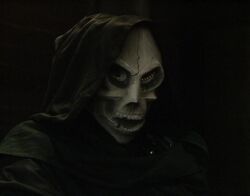(Adding categories) |
mNo edit summary |
||
| Line 1: | Line 1: | ||
{{wikipediainfo}} |
{{wikipediainfo}} |
||
[[File:Grim reaper.jpg|right|thumb|250px|A [[Terileptil android]] dressed so as to assume the likeness of the Grim Reaper. ([[TV]]: ''[[The Visitation (TV story)|The Visitation]]'')]] |
[[File:Grim reaper.jpg|right|thumb|250px|A [[Terileptil android]] dressed so as to assume the likeness of the Grim Reaper. ([[TV]]: ''[[The Visitation (TV story)|The Visitation]]'')]] |
||
| − | The '''Grim Reaper''' was a representation of Death that appeared in the [[mythology]] of many cultures of the [[planet]] [[Earth]]. Early woodcuts showed a [[Weevil]] in a shroud and scythe, implying that the idea of the Grim Reapers came from [[human]]s having associated the Weevils with death. In [[Cardiff]] in [[1479]], [[Death (Dead Man Walking)|a representation of Death]] who resembled a walking skeleton, appeared. The Grim Reaper also appeared on the Death card of the [[Tarot]]. ([[TV]]: ''[[Dead Man Walking]]'') |
+ | The '''Grim Reaper''' was a representation of Death that appeared in the [[mythology]] of many cultures of the [[planet]] [[Earth]]. Early woodcuts showed a [[Weevil]] in a shroud and scythe, implying that the idea of the Grim Reapers came from [[human]]s having associated the Weevils with death. In [[Cardiff]] in [[1479]], [[Death (Dead Man Walking)|a representation of Death]] who resembled a walking skeleton, appeared. The Grim Reaper also appeared on the Death card of the [[Tarot]]. ([[TV]]: ''[[Dead Man Walking (TV story)|Dead Man Walking]]'') |
| − | In [[Heathrow Airport|Heathrow]] in [[1666]], a group of [[Terileptil]]s dressed up their [[Terileptil android|android]] as the Grim Reaper to terrify the superstitious local humans. The fear was especially effective due to an association of the reaper with [[Bubonic Plague]]. ([[TV]]: ''[[The Visitation]]'') |
+ | In [[Heathrow Airport|Heathrow]] in [[1666]], a group of [[Terileptil]]s dressed up their [[Terileptil android|android]] as the Grim Reaper to terrify the superstitious local humans. The fear was especially effective due to an association of the reaper with [[Bubonic Plague]]. ([[TV]]: ''[[The Visitation (TV story)|The Visitation]]'') |
== Behind the scenes == |
== Behind the scenes == |
||
| Line 10: | Line 10: | ||
== Footnotes == |
== Footnotes == |
||
{{reflist}} |
{{reflist}} |
||
| − | |||
[[Category:Personifications of death]] |
[[Category:Personifications of death]] |
||
[[Category:Mythological figures]] |
[[Category:Mythological figures]] |
||
Revision as of 20:45, 13 April 2019

A Terileptil android dressed so as to assume the likeness of the Grim Reaper. (TV: The Visitation)
The Grim Reaper was a representation of Death that appeared in the mythology of many cultures of the planet Earth. Early woodcuts showed a Weevil in a shroud and scythe, implying that the idea of the Grim Reapers came from humans having associated the Weevils with death. In Cardiff in 1479, a representation of Death who resembled a walking skeleton, appeared. The Grim Reaper also appeared on the Death card of the Tarot. (TV: Dead Man Walking)
In Heathrow in 1666, a group of Terileptils dressed up their android as the Grim Reaper to terrify the superstitious local humans. The fear was especially effective due to an association of the reaper with Bubonic Plague. (TV: The Visitation)
Behind the scenes
A leaflet on the series 2 version of the Torchwood website went into the history of the depiction of the embodiment of death. It said that in Slavic paganism, Death took on the form of "a benevolent, philanthropic figure; a woman in white"; a depiction that lasted well into the middle ages, until the figure of the Grim Reaper, or "death as we commonly recognise it in western culture" came to prominence in the 15th century. One of the earliest depictions of "death" dates from the early 15th century — a woodcut discovered in 1905 that depicts "a shrouded figure with a skeletal frame carrying a scythe", alongside two subservient figures with gauntlets suggesting they were knights taken by Death.[1]
Footnotes
- ↑ Episodes - Dead Man Walking - St. Mary's Church - The Grim Reaper (leaflet). BBC - Torchwood. Retrieved on 26 July 2013.
